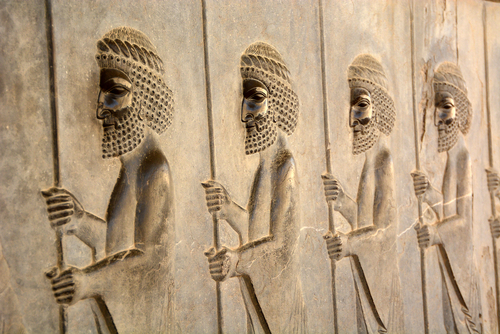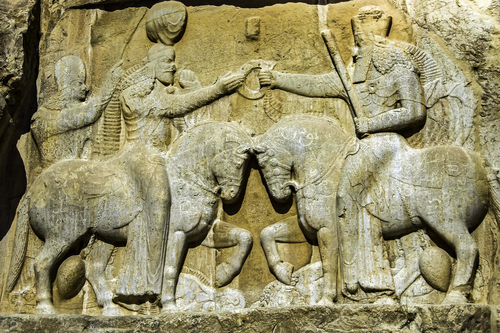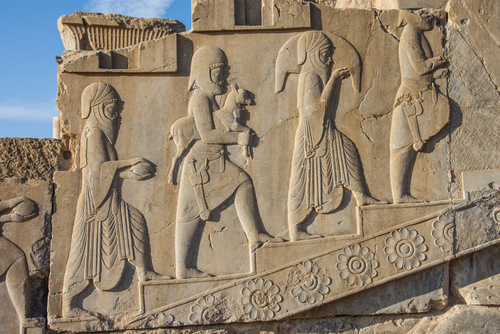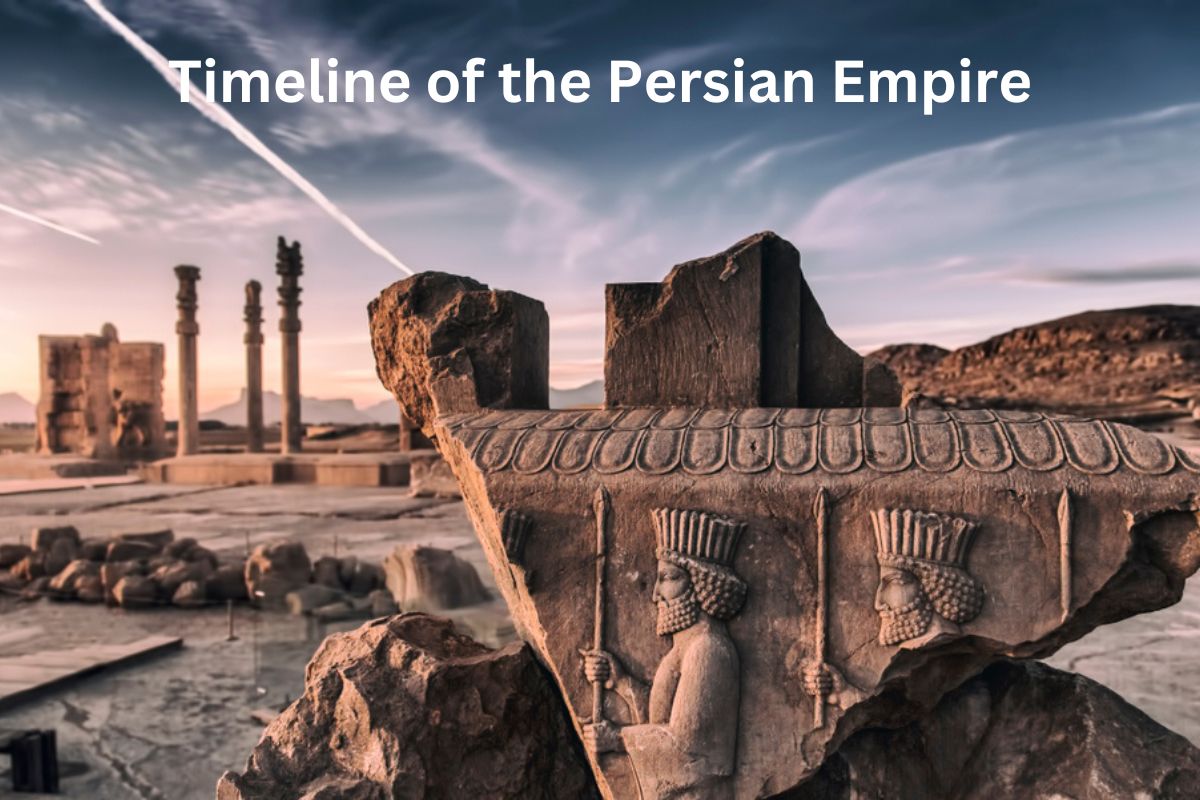The Persian Empire, also known as the Achaemenid Empire, was a vast entity spanning from 550 BC to 330 BC, founded by Cyrus the Great.
After his rule, it underwent a series of transformations under different empires such as the Seleucid, Parthian, and Sassanian. Despite varying political dynamics, these periods significantly influenced Persian civilization.
The Sassanian Empire was the last before the Islamic conquest in 651 AD, which transitioned Persia into Islamic rule.
| Period | Year | Event |
|---|---|---|
| Achaemenid Empire | 550 BC | Cyrus the Great establishes the Achaemenid Empire |
| 539 BC | Cyrus the Great conquers Babylon | |
| 525 BC | Cambyses II conquers Egypt | |
| 522 BC | Darius I comes to power | |
| 490 BC | Persians are defeated by Greeks in the Battle of Marathon | |
| 480 BC | King Xerxes I invades Greece | |
| 330 BC | Alexander the Great of Macedonia conquers the Achaemenid Empire | |
| Macedonian and Seleucid rule | 330–323 BC | Alexander the Great rules the former Persian Empire |
| 323–247 BC | Seleucus I Nicator controls most of the territories of the former Persian Empire | |
| Parthian Empire | 247 BC | Arsaces I establishes the Parthian Empire |
| 53 BC | The Battle of Carrhae where the Parthians defeat the Roman Republic | |
| 224 AD | The Parthian Empire falls to Ardashir I | |
| Sassanian Empire | 224 AD | Ardashir I establishes the Sassanian Empire |
| 260 AD | Shapur I captures the Roman Emperor Valerian | |
| 363 AD | Julian’s Persian War | |
| 628 AD | Heraclius’ campaign results in a Byzantine victory over the Sassanians | |
| 632 AD | Death of the last effective Sassanian King, Yazdegerd III | |
| 651 AD | The Sassanian Empire is conquered by the Rashidun Caliphate |
Persian Empire Timeline
1. Cyrus the Great establishes the Achaemenid Empire (550 BC)
Cyrus the Great is recognized as the founder of the Achaemenid Empire, also known as the First Persian Empire, one of the largest empires in history.
Originating in Persis, which is roughly located in the southwestern part of modern Iran, Cyrus conquered the Median Empire and then the Lydian Empire, and eventually expanded his rule to a vast territory stretching from the Mediterranean Sea and Hellespont in the west to the Indus River in the east.
Also Read: Persian Wars Timeline
His rule was noted for its respect of the cultural and religious practices of its conquered peoples, which helped maintain stability in the empire.

2. Cyrus the Great conquers Babylon (539 BC)
In 539 BC, Cyrus the Great marched into the city of Babylon, bringing an end to the Neo-Babylonian Empire.
According to historical accounts, the city surrendered without a fight. Cyrus’s approach to the capture of Babylon was noted for its humanitarian aspects.
Also Read: Persian Empire Facts
The Cyrus Cylinder, an ancient clay cylinder bearing an inscription in Akkadian cuneiform script, describes the peaceful capture of Babylon and Cyrus’s efforts to improve the lives of the citizens of Babylon, restore temples, and repatriate displaced peoples.
Notably, Cyrus allowed the Jews who had been held captive in Babylon to return to their homeland and rebuild their temple, an event documented in the Bible.
3. Cambyses II conquers Egypt (525 BC)
Cambyses II was the son of Cyrus the Great and his successor to the throne. In 525 BC, Cambyses II led a campaign against Egypt, which was then under the rule of the Pharaoh Psamtik III.
Cambyses II was able to defeat the Egyptian forces at the Battle of Pelusium, and he subsequently captured the capital, Memphis. His conquest marked the start of the 27th Dynasty, when Egypt became a satrapy (province) under the Achaemenid Empire.
However, Cambyses II’s rule over Egypt was marked by several controversies, including accounts of his alleged disrespect towards Egyptian religious traditions and temples.
4. Darius I comes to power (522 BC)
Following the death of Cambyses II, there was a period of unrest and several individuals claimed the throne. One of these was a man named Bardiya (Smerdis in Greek sources), who was either Cambyses II’s brother or an impersonator of him.
Darius I, a distant relative and also an officer in the Persian army, with the support of other nobles, killed Bardiya and took the throne.
After his ascension, Darius I conducted a series of military campaigns to secure rebellious provinces that had attempted to break away in the confusion following Cambyses II’s death.
Darius I is known for the introduction of a standard monetary system, extensive construction projects including the royal city of Persepolis, and for the creation of an efficient administrative system.
5. Persians are defeated by Greeks in the Battle of Marathon (490 BC)
In 490 BC, Darius I launched an expedition against Greece to punish the Athenians and Eretrians for their support of the Ionian Revolt (499-493 BC), an uprising of the Greek cities in Asia Minor against Persian rule.
The Persians landed a force at Marathon, northeast of Athens. The Greeks, however, managed to defeat the Persians decisively at the Battle of Marathon.
This battle is significant as it demonstrated the effectiveness of the heavily armed Greek hoplite infantryman against the lighter armed Persian infantry, and it was a blow to the image of Persian invincibility.

6. King Xerxes I invades Greece (480 BC)
Xerxes I, the son of Darius I, sought to avenge the Persian defeat at Marathon and launched a massive invasion of Greece. The Persian forces were met by a small Greek force at the pass of Thermopylae, which included 300 Spartans led by King Leonidas.
Also Read: Xerxes Facts
Though the Greeks were defeated, their resistance at Thermopylae allowed other Greek city-states time to prepare for the Persian invasion.
Later that year, the Greeks defeated the Persian navy at the Battle of Salamis, which was a major setback for Xerxes and marked the turning point in the conflict.
7. Alexander the Great of Macedonia conquers the Achaemenid Empire (330 BC)
The final blow to the Achaemenid Empire came from Alexander III of Macedonia, known as Alexander the Great.
After securing control of Greece, Alexander launched a campaign against the Persian Empire in 334 BC. He won a series of decisive battles against Persian forces, including the battles of Issus and Gaugamela, which led to the downfall of the Achaemenid Empire.
By 330 BC, Alexander had overthrown Darius III, the last Achaemenid emperor, and took control of the empire’s territories. This began the period known as the Hellenistic Age, when Greek culture spread across the former Persian Empire.
8. Alexander the Great rules the former Persian Empire (330–323 BC)
Following the conquest of the Achaemenid Empire, Alexander the Great ruled over a vast territory that stretched from Greece in the west to India in the east.
Despite his reign being relatively short, it was highly influential in spreading Greek culture, and it marked the beginning of the Hellenistic period.
Alexander adopted some Persian court customs and attempted to integrate the peoples of his empire, encouraging marriages between Greeks and Persians and employing Persians in administrative roles.
Alexander’s sudden death in 323 BC led to a power struggle among his generals, known as the Wars of the Diadochi (Successors).
9. Seleucus I Nicator controls most of the territories of the former Persian Empire (323–247 BC)
After the death of Alexander, his empire was divided among his generals. One of them, Seleucus I Nicator, gained control of the eastern provinces of the former Persian Empire, including Mesopotamia, Persia, and parts of present-day Afghanistan and Pakistan.
This marked the start of the Seleucid Empire. The Seleucid Empire is known for its efforts to blend Greek and Persian cultures, though it was often plagued by internal and external conflicts.
10. Arsaces I establishes the Parthian Empire (247 BC)
The Parthian Empire, also known as the Arsacid Empire, was established by Arsaces I, who led a rebellion against the Seleucid Empire.
Arsaces I was originally a chieftain of the Parni, a nomadic tribe from the region of present-day Turkmenistan.
His successful rebellion marked the start of the Parthian Empire, which would become one of the major powers in the region and a significant rival to the Roman Empire.

11. The Battle of Carrhae where the Parthians defeat the Roman Republic (53 BC)
At the Battle of Carrhae in 53 BC, the Parthians achieved a significant victory over the Roman Republic. The battle is notable for the heavy losses suffered by the Romans, including the death of the Roman general Crassus, who was part of the First Triumvirate along with Julius Caesar and Pompey.
The Parthians’ use of heavy cavalry and archers proved successful against the Roman infantry tactics. The Battle of Carrhae marked a high point in Parthian power and a major setback for Roman expansion in the East.
12. The Parthian Empire falls to Ardashir I (224 AD)
Ardashir I, originally a local Iranian ruler, revolted against the Parthian Empire and successfully overthrew it. This marked the end of the Parthian Empire and the start of the Sassanian Empire.
The Sassanian Empire is considered to be one of the most influential periods of Persia, as it was during this time that Zoroastrianism became the state religion, and the empire became a significant power in the region, engaging in many conflicts with the Roman Empire.
13. Ardashir I establishes the Sassanian Empire (224 AD)
Ardashir I, originally a local ruler from Persis (modern Fars), successfully overthrew the Parthian Empire and established the Sassanian Empire, also known as the Second Persian Empire.
The Sassanian Empire is considered one of the most important and influential historical periods in Iran.
Under the Sassanians, Iran underwent a revival of Persian culture and traditions, which had been somewhat suppressed during the Parthian rule, and Zoroastrianism was promoted as the state religion.
14. Shapur I captures the Roman Emperor Valerian (260 AD)
Shapur I was one of the most successful Sassanian kings, known for his military campaigns against the Roman Empire. In one of the most dramatic moments of these campaigns, Shapur I captured the Roman Emperor Valerian after the Battle of Edessa in 260 AD.
This marked the first time a Roman Emperor was captured as a prisoner of war, which had a demoralizing effect on the Romans.
15. Julian’s Persian War (363 AD)
Emperor Julian, also known as Julian the Apostate, initiated a military campaign against the Sassanian Empire in 363 AD. Julian’s campaign was initially successful, but it eventually ended in disaster.
During a hasty retreat, Julian was mortally wounded and died shortly after. The Romans were then forced to make a peace treaty on unfavorable terms, which included territories ceded to the Sassanians.
16. Heraclius’ campaign results in a Byzantine victory over the Sassanians (628 AD)
In the early 7th century, during the Byzantine-Sassanian War, the Byzantine Emperor Heraclius launched a counter-offensive against the Sassanians, who had earlier conquered many Byzantine territories.
His campaigns were successful, and by 628 AD, he managed to regain the lost territories and even marched into the Sassanian capital of Ctesiphon. This war weakened both the Byzantine and Sassanian Empires, making them vulnerable to the upcoming Islamic invasions.
17. Death of the last effective Sassanian King, Yazdegerd III (632 AD)
Yazdegerd III was the last king of the Sassanian Empire, and his reign was marked by the rapid decline and fall of the empire.
Following the Islamic invasion and the defeat at the Battle of al-Qadisiyyah, the empire was in disarray, and Yazdegerd III was unable to effectively resist the Arab Muslims. He was killed in 632 AD, marking the end of the Sassanian dynasty.
18. The Sassanian Empire is conquered by the Rashidun Caliphate (651 AD)
Following Yazdegerd III’s death, the Arab Muslims, under the Rashidun Caliphate, continued their conquest of the Sassanian Empire. By 651 AD, they had effectively taken control of the former Sassanian territories.
This marked the end of the Sassanian Empire and the start of Islamic rule in Iran. This period saw significant changes in the region, including the gradual conversion of the predominantly Zoroastrian population to Islam.
